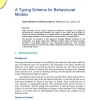Free Online Productivity Tools
i2Speak
i2Symbol
i2OCR
iTex2Img
iWeb2Print
iWeb2Shot
i2Type
iPdf2Split
iPdf2Merge
i2Bopomofo
i2Arabic
i2Style
i2Image
i2PDF
iLatex2Rtf
Sci2ools
100
click to vote
JOT
2007
2007
A Typing Scheme for Behavioural Models
State machines can be used to specify the behaviour of objects in a system by describing the relationships between the states of the object and its ability to respond to events presented to it. Suitable choice of semantics for state machines allow multiple machines to be composed in the description of a single object. We describe an extension to this approach whereby different machines in the composition of a single object have different semantic types covering necessary behaviour, encouraged behaviour and discouraged behaviour. This provides expressive power to model the way software interacts with the domain to encourage or discourage events.
Related Content
| Added | 16 Dec 2010 |
| Updated | 16 Dec 2010 |
| Type | Journal |
| Year | 2007 |
| Where | JOT |
| Authors | Ashley T. McNeile, Nicholas Simons |
Comments (0)

